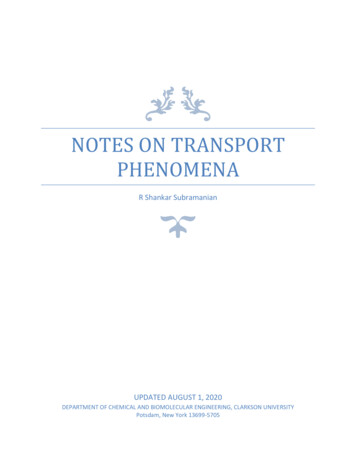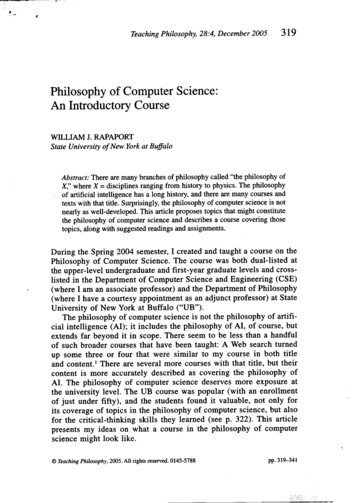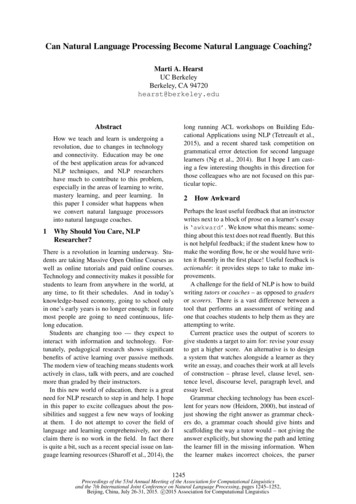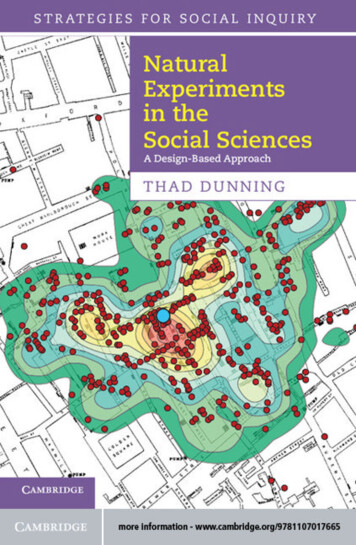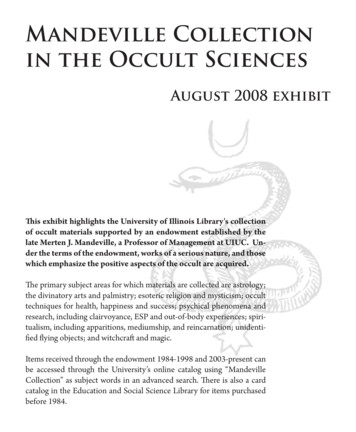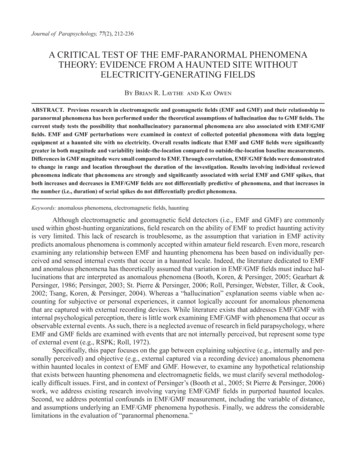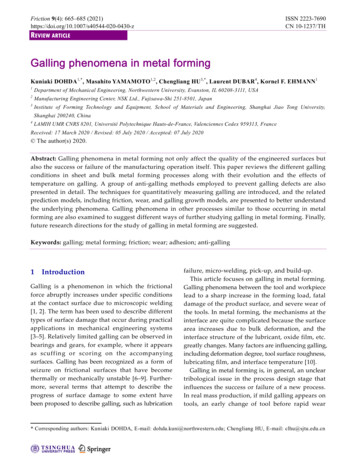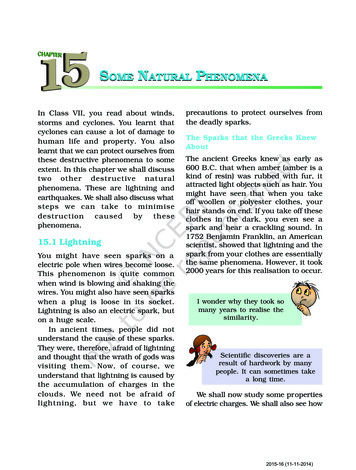
Transcription
SOME NATURAL PHENOMENAIn Class VII, you read about winds,storms and cyclones. You learnt thatcyclones can cause a lot of damage tohuman life and property. You alsolearnt that we can protect ourselves fromthese destructive phenomena to someextent. In this chapter we shall discusstwo other destructive naturalphenomena. These are lightning andearthquakes. We shall also discuss whatsteps we can take to minimisedestructioncausedbythesephenomena.15.1 LightningYou might have seen sparks on aelectric pole when wires become loose.This phenomenon is quite commonwhen wind is blowing and shaking thewires. You might also have seen sparkswhen a plug is loose in its socket.Lightning is also an electric spark, buton a huge scale.In ancient times, people did notunderstand the cause of these sparks.They were, therefore, afraid of lightningand thought that the wrath of gods wasvisiting them. Now, of course, weunderstand that lightning is caused bythe accumulation of charges in theclouds. We need not be afraid oflightning, but we have to takeprecautions to protect ourselves fromthe deadly sparks.The Sparks that the Greeks KnewAboutThe ancient Greeks knew as early as600 B.C. that when amber (amber is akind of resin) was rubbed with fur, itattracted light objects such as hair. Youmight have seen that when you takeoff woollen or polyester clothes, yourhair stands on end. If you take off theseclothes in the dark, you even see aspark and hear a crackling sound. In1752 Benjamin Franklin, an Americanscientist, showed that lightning and thespark from your clothes are essentiallythe same phenomena. However, it took2000 years for this realisation to occur.I wonder why they took somany years to realise thesimilarity.Scientific discoveries are aresult of hardwork by manypeople. It can sometimes takea long time.We shall now study some propertiesof electric charges. We shall also see how2015-16 (11-11-2014)
they are related to the lightning in thesky.Let us perform some activities tounderstand the nature of electriccharges. But recall first what you mighthave played as a game. When you ruba plastic scale on your dry hair, thescale can attract very small pieces ofpaper.15.2 Charging by RubbingActivity 15.1Take a used ballpen refill and rubit vigorously with a piece ofpolythene. Bring it close to smallpieces of paper. Take care not totouch the rubbed end of the refillwith your hand or with a metallicobject. Repeat the activity with smallpieces of dry leaf, husk and mustardseeds. Record your observations.When a plastic refill is rubbed withpolythene, it acquires a small electriccharge. Similarly, when a plastic combis rubbed with dry hair, it acquires asmall charge. These objects are calledcharged objects. In the process ofcharging the refill and the plastic comb,polythene and hair also get charged.Let’s try to charge some otherobjects that are familiar to you.Activity 15.2Collect the objects and the materials listed in Table 15.1. Try to charge eachby rubbing with the materials mentioned in the Table. Record your findings.You can add more items to the Table.Table 15.1Objects RubbedMaterialsUsed for RubbingRefillPolythene,woollen clothBalloonPolythene, woollencloth, dry hairEraserWoolSteel spoonPolythene,woollen clothS OME NATURAL PHENOMENAAttracts/does notAttract Piecesof PaperCharged/Not Charged1852015-16 (11-11-2014)
15.3 Types of Charges andTheir InteractionWe will select some objects from Table15.1 for the next activity.Activity 15.3(a) Inflate two balloons. Hang themin such a way that they do not toucheach other (Fig. 15.1). Rub both theballoons with a woollen cloth andrelease them. What do you observe?Rub the other refill also withpolythene. Bring it close to thecharged refill. Be careful not totouch the charged end with yourhand. Is there any effect on the refillin the tumbler? Do the two attracteach other, or repel each other?In this activity we have broughtclose together the charged objectsthat were made of the samematerial. What happens if twocharged objects made of differentmaterials are brought close to eachother? Let’s find out.(b) Rub a refill and place it gentlyin a glass tumbler as before (Fig.15.3). Bring an inflated chargedballoon near the refill and observe.Fig. 15.1 : Like charges repel each otherNow let us repeat this activitywith the used pen refills. Rub onerefill with polythene. Place itcarefully in a glass tumbler usingthe tumbler as a stand (Fig. 15.2).Fig. 15.3 : Unlike charges attract each otherFig. 15.2 : Interaction between like charges186Let’s summarise the observations:l A charged balloon repelled a chargedballoon.l A charged refill repelled a chargedrefill.l But a charged balloon attracted acharged refill.Does it indicate that the charge onthe balloon is of a different kind fromthe charge on the refill? Can we saythen, that there are two kinds ofSCIENCE2015-16 (11-11-2014)
charges? Can we also say that thecharges of the same kind repel eachother, while charges of different kindattract each other?It is a convention to call the chargeacquired by a glass rod when it isrubbed with silk as positive. Theother kind of charge is said to benegative.It is observed that when a chargedglass rod is brought near a chargedplastic straw rubbed with polythenethere is attraction between the two.What do you think would be the kindof charge on the plastic straw? Yourguess, that the plastic straw would carrya negative charge is correct.The electrical charges generated byrubbing are static. They do not move bythemselves. When charges move, theyconstitute an electric current. You havebeen reading about electric current sinceClass VI. The current in a circuit whichmakes a bulb glow, or the current thatmakes a wire hot, is nothing but amotion of charges.with the end of the paper clip.Observe what happens. Is there anyeffect on the foil strips? Do theyrepel each other or attract eachother? Now, touch other chargedbodies with the end of the paper clip.Do foil strips behave in the sameway in all cases? Can this apparatusbe used to detect whether a body ischarged or not? Can you explainwhy the foil strips repel each other?Fig 15.4 : A simple electroscope15.4 Transfer of ChargeActivity 15.4Take an empty jam bottle. Take apiece of cardboard slightly bigger insize than the mouth of the bottle.Pierce a hole in it so that a metalpaper clip can be inserted. Open outthe paper clip as shown in Fig. 15.4.Cut two strips of aluminium foilabout 4 cm 1 cm each. Hang themon the paper clip as shown. Insertthe paper clip in the cardboard lidso that it is perpendicular to it (Fig.15.4). Charge a refill and touch itS OME NATURAL PHENOMENAThe aluminium foil strips receive thesame charge from the charged refillthrough the paper clip (remember thatmetals are good conductors ofelectricity). The strips carrying similarcharges repel each other and theybecome wide open. Such a device canbe used to test whether an object iscarrying charge or not. This device isknown as electroscope.Thus, we find that electrical chargecan be transferred from a charged objectto another through a metal conductor.Touch the end of the paper clip gentlywith hand and you will find a change in1872015-16 (11-11-2014)
the foil strips. They come back to theiroriginal state. Repeat charging of foilstrips and touching the paper clip. Everytime you will find that the foil stripscollapse as soon as you touch thepaperclip with hand. Why does ithappen? The reason is that the foil stripslose charge to the earth through yourbody. We say that the foil strips aredischarged. The process of transferringof charge from a charged object to theearth is called earthing.Earthing is provided in buildings toprotect us from electrical shocks dueto any leakage of electrical current.15.5 The Story of LightningIt is now possible to explain lightningin terms of the charges produced byrubbing.You learnt in Class VII that duringthe development of a thunderstorm, theair currents move upward while thewater droplets move downward. Thesevigorous movements cause separationof charges. By a process, not yetcompletely understood, the positivecharges collect near the upper edges ofthe clouds and the negative chargesaccumulate near the lower edges. Thereis accumulation of positive charges nearthe ground also. When the magnitudeof the accumulated charges becomes verylarge, the air which is normally a poorconductor of electricity, is no longer ableto resist their flow. Negative and positivecharges meet, producing streaks ofbright light and sound. We see streaksas lightning (Fig. 15.5). The process iscalled an electric discharge.Fig 15.5 : Accumulation of charges leading to lightning.188SCIENCE2015-16 (11-11-2014)
The process of electric discharge canoccur between two or more clouds, orbetween clouds and the earth. Today weneed not get frightened by lightning likeour ancestors did. Now we understandthe basic phenomenon. Scientists aretrying hard to improve thisunderstanding. However, lightningstrike could destroy life and property. Itis, therefore, necessary to take measuresto protect ourselves.metal objects. Do not lie on the ground.Instead, squat low on the ground. Placeyour hands on your knees with yourhead between the hands (Fig. 15.6). Thisposition will make you the smallesttarget to be struck.15.6 Lightning SafetyDuring lightning and thunderstorm noopen place is safe.l Hearing thunder is an alert to rushto a safer place.l After hearing the last thunder, waitfor some time before coming out ofthe safe place.Finding a Safe PlaceA house or a building is a safe place.If you are travelling by car or by bus,you are safe inside with windows anddoors of the vehicle shut.Do’s and Don’ts during aThunderstormOutsideOpen vehicles, like motorbikes, tractors,construction machinery, open cars arenot safe. Open fields, tall trees, sheltersin parks, elevated places do not protectus from lightning strokes.Carrying an umbrella is not at all agood idea during thunderstorms.If in a forest, take shelter undershorter trees.If no shelter is available and you arein an open field, stay far away from alltrees. Stay away from poles or otherS OME NATURAL PHENOMENAFig. 15.6 : Safe position during lightningInside the houseLightning can strike telephone cords,electrical wires and metal pipes (Do youremember, lightning is an electricaldischarge?). During a thunderstormcontact with these should be avoided. Itis safer to use mobile phones andcordless phones. However, it is not wiseto call up a person who is receiving yourphone through a wired phone.Bathing should be avoided duringthunderstorms to avoid contact withrunning water.Electrical appliances like computers,TVs, etc., should be unplugged. Electricallights can remain on. They do not causeany harm.1892015-16 (11-11-2014)
Lightning Conductors15.7 EarthquakesLightning Conductor is a device usedto protect buildings from the effect oflightning. A metallic rod, taller than thebuilding, is installed in the walls of thebuilding during its construction. Oneend of the rod is kept out in the air andthe other is buried deep in the ground(Fig. 15.7). The rod provides easy routefor the transfer of electric charge to theground.The metal columns used duringconstruction, electrical wires and waterpipes in the buildings also protect us toan extent. But do not touch them duringa thunderstorm.You just learnt about thunderstorm andlightning. In Class VII you learnt aboutcyclones. These natural phenomena cancause large scale destruction of humanlife and property. Fortunately, thesephenomena can be predicted to someextent. The weather department canwarn about a thunderstorm developingin some area.If a thunderstorm occurs there isalways a possibility of lightning andcyclones accompanying it. So, we gettime to take measures to protectourselves from the damage caused bythese phenomena.lightningconductorcopperplateFig. 15.7 : Lightning conductor190SCIENCE2015-16 (11-11-2014)
Ther e is, however, one naturalphenomenon which we are not yet ableto predict accurately.It is anearthquake. It can cause damage tohuman life and property on a huge scale.A major earthquake occurred in Indiaon 8 October 2005 in Uri and TangdhartownsofNorthKashmir(Fig. 15.8). Before that a majorearthquake occurred on 26 January2001 in Bhuj district of Gujarat.Activity 15.5caused by these earthquakes fromnewspapers and magazines of thosedays. Prepare a short report on thesuffering of the people during andafter the earthquakes.What is an earthquake? Whathappens when it occurs? What can wedo to minimise its effects? These aresome of the questions which we shalldiscuss below.What is an Earthquake?Ask your parents about the hugedamage to life and property causedby these earthquakes. Collect a fewpictures showing the damageAn earthquake is a sudden shaking ortrembling of the earth which lasts for avery short time. It is caused by adisturbance deep inside the earth’sFig. 15.8 : Kashmir earthquakeS OME NATURAL PHENOMENA1912015-16 (11-11-2014)
crust. Earthquakes occur all the time,all over the earth. They are not evennoticed. Major earthquakes are muchless frequent. They can cause immensedamage to buildings, bridges, dams andpeople. There can be a great loss to lifeand property. Earthquakes can causefloods, landslides and tsunamis. Amajor tsunami occurred in the IndianOcean on 26 December 2004. All thecoastal areas around the ocean sufferedhuge losses.What could cause adisturbance insidethe earth?Now we know that the tremors arecaused by the disturbance deep downinside the uppermost layer of the earthcalled the crust (Fig. 15.9).crustActivity 15.6Take an outline map of the world.Locate the eastern coast andAndaman and Nicobar Islands inIndia. Mark other countries aroundthe Indian Ocean which could havesuffered damage. Collect accountsof the devastation caused by thetsunami in India from your parents,or other elders in the family or inthe neighbourhood.What Causes an Earthquake?mantleoutercoreinnercoreFig. 15.9 : Structure of the earthThe outermost layer of the earth isnot in one piece. It is fragmented. Eachfragment is called a plate (Fig. 15.10).These plates are in continual motion.When they brush past one another, orMy grandmother told methat the earth is balancedon the horn of a bull andwhen the bull shifts it tothe other horn, anearthquake takes place.How could it be true?In ancient times, people did not knowthe true cause of earthquakes. Theirideas were, therefore, expressed inmythical stories such as the one told byBoojho’s grandmother. Similar mythswere prevalent in other parts of theworld.192EurasianPlateArabianPlate IndanPlateFig. 15.10 : Earth platesSCIENCE2015-16 (11-11-2014)
a plate goes under another due tocollision (Fig. 15.11), they causedisturbance in the earth’s crust. It isthis disturbance that shows up as anearthquake on the surface of the earth.CollidingBrushingpastcarried out. However, most earthquakesare caused by the movement of earth’splates.Since earthquakes are caused by themovement of plates, the boundaries ofthe plates are the weak zones whereearthquakes are more likely to occur.The weak zones are also known asseismic or fault zones. In India, theareas most threatened are Kashmir,Western and Central Himalayas, thewhole of North-East, Rann of Kutch,Rajasthan and the Indo–Gangetic Plane.Some areas of South India also fall inthe danger zone (Fig. 15.12).Fig. 15.11 : Movements of earth’s platesIf scientists know so muchabout earthquakes, canthey also predict when andwhere the next one willstrike?Although, we know for sure whatcauses an earthquake, it is not yetpossible to predict when and where thenext earthquake might occur.Fig. 15.12 : Movements of Indian earth’s plateI read somewhere thatunderground explosionscould also causetremors.Tremors on the earth can also becaused when a volcano erupts, or ameteor hits the earth, or anunderground nuclear explosion isS OME NATURAL PHENOMENAThe power of an earthquake isexpressed in terms of a magnitudeon a scale called the Richter scale.Really destructive earthquakes havemagnitudes higher than 7 on theRichter scale. Both Bhuj and Kashmirearthquakes had magnitudes greaterthan 7.5.1932015-16 (11-11-2014)
The tremors produce waves on the surface of the earth. These are calledseismic waves. The waves are recorded by an instrument called theseismograph (Fig. 15.13). The instrument is simply a vibrating rod, or apendulum, which starts vibrating when tremors occur. A pen is attached tothe vibrating system. The pen records the seismic waves on a paper whichmoves under it. By studying these waves, scientists can construct a completemap of the earthquake, as shown in Fig. 15.14. They can also estimate itspower to cause avesInside the earthA typical seismograph recordFig. 15.13 : A seismographFig. 15.14 : Map of the earthquakeLike many other scales in science (decibel is another example), Richter scaleis not linear. This means that an earthquake of magnitude 6 does not haveone and half times the destructive energy of an earthquake of magnitude 4.In fact, an increase of 2 in magnitude means 1000 times more destructiveenergy. Therefore, an earthquake of magnitude 6 has thousand times moredestructive energy than an earthquake of magnitude 4.Protection against EarthquakesWe know from the earlier pages thatearthquakes cannot be predicted. Wehave also seen that they can be highlydestructive. It is, therefore, importantthat we take necessary precautions toprotect ourselves all the time. People194living in seismic zones, where theearthquakes are more likely to occur,have to be specially prepared. First ofall, the buildings in these zones shouldbe so designed that they can withstandmajor tremors. Modern buildingtechnology can make it possible.SCIENCE2015-16 (11-11-2014)
It is advisable to make the structuresimple so that it is ‘Quake Safe’.lllllConsult qualified architects andstructural engineers.In highly seismic areas, the use ofmud or timber is better than usingheavy construction material. Keeproofs as light as possible. In casethe structure falls, the damage willnot be heavy.It is better if the cupboards andshelves are fixed to the walls, so thatthey do not fall easily.Be careful where you hang wallclocks, photo-frames, water heatersetc., so that in the event of anearthquake, they do not fall onpeople.Since some buildings may catch firedue to an earthquake, it is necessarythat all buildings, especially tallbuildings, have fire fightingequipment in working order.S OME NATURAL PHENOMENAThe Central Building ResearchInstitute, Roorkee, has developedknowhow to make quake-resistanthouses.In the event that an earthquake doesstrike, take the following steps to protectyourself.1. If you are at homel Take shelter under a table and staythere till the shaking stops.l Stay away from tall and heavy objectsthat may fall on you.l If you are in bed, do not get up.Protect your head with a pillow.2. If you are outdoorsl Find a clear spot, away frombuildings, trees and overhead powerlines. Drop to the ground.l If you are in a car or a bus, do notcome out. Ask the driver to driveslowly to a clear spot. Do not comeout till the tremors stop.1952015-16 (11-11-2014)
KEYWORDSCRUSTWHAT YOU HAVE LEARNTÜother objects.DISCHARGEEARTH’S PLATESSome objects can be charged by rubbing withÜThere are two kinds of charges — positivecharge and negative chargeEARTHQUAKEELECTROSCOPEÜeach other.ÜLIGHTNINGLIGHTNINGCONDUCTORRICHTER SCALEThe electrical charges produced by rubbingare called static charges.ÜWhen charges move, they constitute anelectric current.ÜAn electroscope may be used to detectwhether a body is charged or not.NEGATIVE CHARGEPOSITIVE CHARGELike charges repel and unlike charges attractÜThe process of transfer of charge from acharged object to the earth is called earthing.ÜThe process of electric discharge betweenclouds and the earth or between differentSEISMOGRAPHTHUNDERclouds causes lightning.ÜLightning strike could destroy life andproperty.THUNDERSTORMÜfrom the effects of lightning.TRANSFER OFCHARGELightning conductors can protect buildingsÜAn earthquake is a sudden shaking ortrembling of the earth.TSUNAMITREMORÜEarthquake is caused by a disturbance deepinside the earth’s crust.ÜIt is not possible to predict the occurrence ofan earthquake.ÜEarthquakes tend to occur at the boundariesof earth’s plates. These boundaries are knownas fault zones.ÜDestructive energy of an earthquake ismeasured on the Richter scale. Theearthquake measuring 7 or more on Richterscale can cause severe damage to life andproperty.ÜWe should take necessary precautions toprotect ourselves from earthquakes.196SCIENCE2015-16 (11-11-2014)
ExercisesSelect the correct option in Questions 1 and 2.1.Which of the following cannot be charged easily by friction?(a) A plastic scale(b) A copper rod(c) An inflated balloon(d) A woollen cloth.2.When a glass rod is rubbed with a piece of silk cloth the rod(a) and the cloth both acquire positive charge.(b) becomes positively charged while the cloth has a negative charge.(c) and the cloth both acquire negative charge.(d) becomes negatively charged while the cloth has a positive charge.3.Write T against true and F against false in the following statements.(a) Like charges attract each other (T/F)(b) A charged glass rod attract a charged plastic straw (T/F)(c) Lightning conductor cannot protect a building from lightning (T/F)(d) Earthquakes can be predicted in advance (T/F)4.Sometimes, a crackling sound is heard while taking off a sweater duringwinters. Explain.5.Explain why a charged body loses its charge if we touch it with our hand.6.Name the scale on which the destructive energy of an earthquake ismeasured. An earthquake measures 3 on this scale. Would it be recordedby a seismograph? Is it likely to cause much damage?7.Suggest three measures to protect ourselves from lightning.8.Explain why a charged balloon is repelled by another charged balloonwhereas an uncharged balloon is attracted by another charged balloon?9.Describe with the help of a diagram an instrument which can be used todetect a charged body.10.List three states in India where earthquakes are more likely to strike.11.Suppose you are outside your home and an earthquake strikes. Whatprecaution would you take to protect yourself?12.The weather department has predicted that a thunderstorm is likely tooccur on a certain day. Suppose you have to go out on that day. Would youcarry an umbrella? Explain.S OME NATURAL PHENOMENA1972015-16 (11-11-2014)
Extended Learning — Activities and Projects1.Open a water tap. Adjust the flow so that it forms a thin stream.Charge a refill. Bring it near the water stream. Observe whathappens. Write a short report on the activity.2.Make your own charge detector. Take a paper strip roughly 10 cm 3 cm. Give it a shape as shown in Fig. 15.15. Balance it on aneedle. Bring a charged body near it. Observe what happens. Writea brief report, explaining its working.Paper 10 cm 3 cmFold along the dotted lineCut along the dotted lineNeedleThermoColeFig. 15.153.4.This activity should be performed at night. Go to a room where thereis a fluorescent tube light. Charge a balloon. Switch off the tube lightso that the room is completely dark. Bring the charged balloon nearthe tubelight. You should see a faint glow. Move the balloon alongthe length of the tube and observe how the glow changes.Caution : Do not touch the metal parts of the tube or the wiresconnecting the tube with the mains.Find out if there is an organisation in your area which providesrelief to those suffering from natural disaster. Enquire about thetype of help they render to the victims of earthquakes. Prepare abrief report on the problems of the earthquake victims.For more information on these topics, 5-16 (11-11-2014)
occur between two or more clouds, or between clouds and the earth. Today we need not get frightened by lightning like our ancestors did. Now we understand the basic phenomenon. Scientists are trying hard to improve this understanding. However, lightning strike could destroy life and prop
